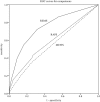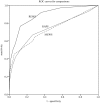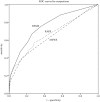Comparing the effectiveness of three scoring systems in predicting adult patient outcomes in the emergency department
- PMID: 30702597
- PMCID: PMC6380692
- DOI: 10.1097/MD.0000000000014289
Comparing the effectiveness of three scoring systems in predicting adult patient outcomes in the emergency department
Abstract
This study aimed to evaluate the performance of the rapid acute physiology score (RAPS), the rapid emergency medicine score (REMS), and the modified early warning score (MEWS) in predicting the outcomes of adult patients presenting to the emergency department (ED).A retrospective review was undertaken between February 2014 and February 2018 in an adult ED of a 3300-bed university hospital. The RAPS, REMS, and MEWS were calculated to assess their capability to predict hospital admission, length of hospital stay, and in-hospital mortality, using area under receiver operating characteristic analysis. Multivariate analysis was used to identify variables that were independent predictors of the outcomes.We included 39,977 patients who had presented to the ED during 48 consecutive months, of whom 4857 were admitted and 213 died in hospital. The predictabilities of REMS, RAPS, and MEWS for hospital admission were 0.76, 0.59, and 0.55, respectively; the predictability of REMS, RAPS, and MEWS for hospital mortality were 0.88, 0.72, and 0.73, respectively; and the predictability of REMS, RAPS, and MEWS for length of hospital stay were 0.76, 0.67, and 0.65, respectively. Multivariate analysis showed that the Glasgow coma scale (GCS) (odds ratio (OR), 1.61; P < .001), age (OR, 1.50; P < .001), and MAP (OR, 1.27; P < .001) were independent predictors for hospital admission; GCS (OR, 2.92; P < .001), respiratory rate (RR) (OR, 2.69; P < .001), peripheral oxygen saturation (OR, 2.67; P < .001), MAP (OR, 2.11; P < .001), age (OR, 1.75; P < .001), and pulse rate (PR) (OR, 1.73; P < .001) were independent predictors for in-hospital mortality; and RR (OR, 1.41; P < .001), temperature (OR, 1.05; P = .01), and PR (OR, 0.96; P = .04) were independent predictors for length of hospital stay.Our study evaluated and confirmed the REMS as a powerful predictor of ED adult patient outcomes, including hospital admission, length of hospital stay, and in-hospital mortality compared to RAPS and MEWS.
Figures



Similar articles
-
Rapid Emergency Medicine score: a new prognostic tool for in-hospital mortality in nonsurgical emergency department patients.J Intern Med. 2004 May;255(5):579-87. doi: 10.1111/j.1365-2796.2004.01321.x. J Intern Med. 2004. PMID: 15078500
-
Rapid Emergency Medicine Score: A novel prognostic tool for predicting the outcomes of adult patients with hepatic portal venous gas in the emergency department.PLoS One. 2017 Sep 15;12(9):e0184813. doi: 10.1371/journal.pone.0184813. eCollection 2017. PLoS One. 2017. PMID: 28915258 Free PMC article.
-
The comparison of modified early warning score with rapid emergency medicine score: a prospective multicentre observational cohort study on medical and surgical patients presenting to emergency department.Emerg Med J. 2014 Jun;31(6):476-81. doi: 10.1136/emermed-2013-202444. Epub 2013 Apr 6. Emerg Med J. 2014. PMID: 23562988
-
The use of early warning system scores in prehospital and emergency department settings to predict clinical deterioration: A systematic review and meta-analysis.PLoS One. 2022 Mar 17;17(3):e0265559. doi: 10.1371/journal.pone.0265559. eCollection 2022. PLoS One. 2022. PMID: 35298560 Free PMC article.
-
The Value of Physiological Scoring Criteria in Predicting the In-Hospital Mortality of Acute Patients; a Systematic Review and Meta-Analysis.Arch Acad Emerg Med. 2021 Sep 9;9(1):e60. doi: 10.22037/aaem.v9i1.1274. eCollection 2021. Arch Acad Emerg Med. 2021. PMID: 34580658 Free PMC article. Review.
Cited by
-
Evaluation of prognostic scoring systems in patients hospitalized from the emergency department in a low-income region: northern Syria after internal turmoil as a different universe.Turk J Med Sci. 2023 Feb;53(1):382-395. doi: 10.55730/1300-0144.5595. Epub 2023 Feb 22. Turk J Med Sci. 2023. PMID: 36945949 Free PMC article.
-
Comparison of Nine Early Warning Scores for Identification of Short-Term Mortality in Acute Neurological Disease in Emergency Department.J Pers Med. 2022 Apr 14;12(4):630. doi: 10.3390/jpm12040630. J Pers Med. 2022. PMID: 35455748 Free PMC article.
-
Performance of Scoring Systems in Predicting Clinical Outcomes in Patients with Bacteremia of Listeria monocytogenes: A 9-Year Hospital-Based Study.Biology (Basel). 2021 Oct 21;10(11):1073. doi: 10.3390/biology10111073. Biology (Basel). 2021. PMID: 34827066 Free PMC article.
-
Internal validation and comparison of the prognostic performance of models based on six emergency scoring systems to predict in-hospital mortality in the emergency department.BMC Emerg Med. 2021 Jun 10;21(1):68. doi: 10.1186/s12873-021-00459-7. BMC Emerg Med. 2021. PMID: 34112088 Free PMC article.
-
Good Performance of Revised Scoring Systems in Predicting Clinical Outcomes of Aeromonas Bacteremia in the Emergency Department: A Retrospective Observational Study.Diagnostics (Basel). 2024 Jan 5;14(2):124. doi: 10.3390/diagnostics14020124. Diagnostics (Basel). 2024. PMID: 38248001 Free PMC article.
References
-
- Hung SK, Ng CJ, Kuo CF, et al. Comparison of the mortality in emergency department sepsis score, modified early warning score, rapid emergency medicine score and rapid acute physiology score for predicting the outcomes of adult splenic abscess patients in the emergency department. PLoS One 2017;12:e0187495. - PMC - PubMed
-
- Williams TA, Tohira H, Finn J, et al. The ability of early warning scores (EWS) to detect critical illness in the prehospital setting: a systematic review. Resuscitation 2016;102:35–43. - PubMed
-
- Singer AJ, Ng J, Thode HC, Jr, et al. Quick SOFA scores predict mortality in adult emergency department patients with and without suspected infection. Ann Emerg Med 2017;69:475–9. - PubMed
Publication types
MeSH terms
LinkOut - more resources
Full Text Sources
Research Materials

